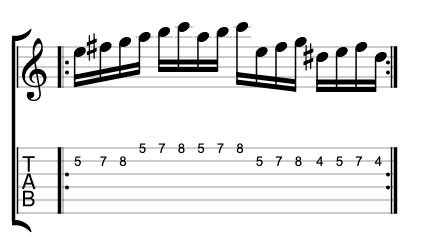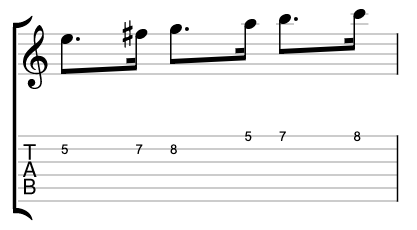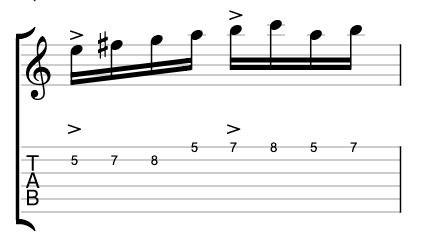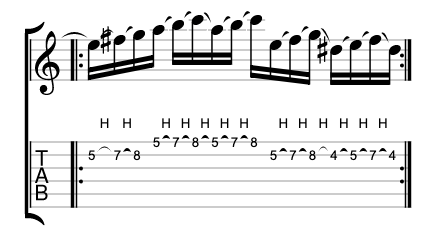It’s boring Friday and I’m mentally exhausted after my first baby steps with the Stream of consciousness solo, and decided to raise the question: how do you get faster when you are not slow anymore? Recently I made quite a big jump in terms of speed but it was like a rapid transition, it literally happened in a few days. Playing fast doesn’t seem like an impossible goal anymore but when I started learning a few Dream Theater solos, I’ve realised there’s still ~10-15 bpm missing. How does one tackle this challenge to get those final bpms done and make that final jump? Any kind of advice, suggestion is appreciated.
Our latest “official” advice is to take the motion tests in this section, and see how they compare to the speed of your guitar playing:
If you find that in one of the tests you are much faster than you are on guitar, the suggestion is to try and figure out how to reproduce a similar motion with pick & guitar. Not easy for sure — but neither is the Stream of Consciousness solo 
Edit: another method that I really like to to explore higher speeds by mixing pick & legato. Sometimes the obsession with picking every note is limiting. But don’t take my word for it 
I did this in February when started my neverending thread  All of these motions were much faster than my current speed. My fastest motion is a kind of forearm rotation similar to Van Halen’s BUT I could never ever pick like that on the guitar.
All of these motions were much faster than my current speed. My fastest motion is a kind of forearm rotation similar to Van Halen’s BUT I could never ever pick like that on the guitar.
Edit: I also don’t want to change to USX (for now!!  )
)
Hi @gabrielthorn. I haven’t watched all your videos, but what I’ve seen/heard sure sounds fast to me 
I fully understand your drive and willingness to always be better than what you are, but I also know from the other threads that you seem to think you are worse than you really are. Please keep that in mind so you don’t lose sight of the big picture. You mentioned how quickly you gained speed…be proud about that! Focusing on our shortcomings makes us feel bad. Focusing on accomplishments makes us feel good  Mindset can be something that holds us back.
Mindset can be something that holds us back.
More concretely (since I don’t know the exact bpms) what is the fastest you can currently play with your elbow mechanic? Sometimes what I’ll do to test why I can’t play something as fast as I’d like to is isolate the left/right hands. I don’t advocate practicing this way, but it helps identify where the bottleneck is. For example, if you can pick fast enough, but you realize that doing the left hand motion (all hammers, lightly) is not as fast – you’ve got your answer. If that’s the case, just go and read all of Tom Gilroy’s threads and you should be set  If your left hand can mime the motions but you find you can’t pick fast enough, try to figure out why. From what I’ve seen, you can move your pick pretty fast. Then maybe it’s the string changes??? That could require you to re-finger what you’re trying to play, or add hammers/pulloffs/slides where needed. I am not a Petrucci authority, but several of his fast phrases that I’ve tried I learned quickly were not compatible with DSX. So I needed to either add a hammer/pulloff here and there, or find a swiping strategy that worked.
If your left hand can mime the motions but you find you can’t pick fast enough, try to figure out why. From what I’ve seen, you can move your pick pretty fast. Then maybe it’s the string changes??? That could require you to re-finger what you’re trying to play, or add hammers/pulloffs/slides where needed. I am not a Petrucci authority, but several of his fast phrases that I’ve tried I learned quickly were not compatible with DSX. So I needed to either add a hammer/pulloff here and there, or find a swiping strategy that worked.
Again, I have no idea if that’s true across the board for him…he seems like he can play ANYTHING…but he is a wrist player and based on what I understand from Troy’s posts, the wrist is such a versatile joint that it can use very subtle helper motions wherever needed. That could mean it’s trickier to play this stuff with an elbow mechanic, if you aren’t aware of where the helper motions are needed.
Anyway, stay positive and best of luck on your continued (amazing!) progress.
Thank you for your reply. My biggest bottleneck is my raw picking speed I think. I can do maximum 2 bars, playing 16th notes on 210 bpm now. (It was around 190 in the beginning of February). I can’t sustain it any longer without my arm getting tense. On 200 bpm I can sustain a much longer tremolo.
I’m also changing the picking / fretting slightly sometimes for Petrucci stuff, to make the string shifts more easier. Sometimes I’m wondering how can someone play that fast sounding so good no matter if the runs have a lot of upstroke or downstroke string changes.
Edit: I also noticed, that anything above 200 bpm feels exactly the same. I cranked up the metronome now to 220 and it feels just like 210. I also tried 230, same.
I try to brute-force stuff at 218 bpm
Even on 210 the position shifts with the fretting hand are off and I keep falling behind the beat
I’d be happy if I could keep playing on this sloppy level at 210 if my freeting hand could keep up and my picking hand could sustain the picking 
Interesting. I can see why you chose your thread title. That is not slow!!!
I haven’t practiced just doing an elbow driven tremolo since I did a technique critique. I just tried it, and I can’t do a ton better than what you’re reporting. What’s worse, I can’t play actual music with this motion lol. But similarly, when I get to my ‘fastest’ I tense up and can’t go for more than a couple measures either. To me this seems like a coordination thing.
What’s been working well for me lately in other areas that require coordination are short bursts. I know in some contexts that is frowned up on here, BUT hear me out:
If I can comfortably play at 225bpm doing a tremolo, but I can only sustain it for about a measure before I tense up…what should I do? Playing longer durations at a slower speed won’t do me any good. I think that multiple repetitions at the high speed before the tension sets in is the answer. What we need is lots of “good” practice, feeling controlled, of this new higher speed. If can play one measure with no tension, then stop, reset and do it again, over and over, what have I achieved? Several times performing the motion at the high speed, flawlessly and in control without tension. I think this programs it in. If you can gradually add more beats/measures I think the result would be good. Worth a try?
EDIT:
Just watched your videos. They’re better than you think they are, as per the usual with you  Yeah, it drifts by the end, but there are some good reps in there!!! I’d honestly just keep playing what you’re playing, pushing it like you’re doing. Maybe try my burst idea a little here and there? I like it because it helps with hand sync, and reminds me to relax (and what relaxed feels like)
Yeah, it drifts by the end, but there are some good reps in there!!! I’d honestly just keep playing what you’re playing, pushing it like you’re doing. Maybe try my burst idea a little here and there? I like it because it helps with hand sync, and reminds me to relax (and what relaxed feels like)
Out of curiosity, what happens if you play this over and over as fast as you can? It’s a little variation on the riff you started out with in the second video, but it’s more efficient with both the picking and the fretting
|---------17-19-20-17-19-20----------------------|
|-17-19-20------------------17-19-20-16-17-19-16-|
|------------------------------------------------|
|------------------------------------------------|
|------------------------------------------------|
|------------------------------------------------|
That doesn’t require any swiping (or helper escape) at all and the left hand fingers can comfortably just go 1 2 3 the whole time. It should be easier to play faster than what you were doing, so if nothing else it can be a little helper exercise to get you comfortable at those crazy high speeds.
I already mentioned ways up improve speed in your “first” thread, but here it goes again:
- Experiment with your forearm angle being more parallel to your neck.
- Find the spot along the length of the string that has enough give to not feel challenging when you pick.
- Analyze what other motions might be in there. Last month or so I came to the realization that I have more finger motion than I thought, as well as a little forearm rotation along with wrist movement. My picking seems to be a combo of all 3.
Hi @gabrielthorn, I just checked out the first video, looks super!
Well that’s pretty bangin’. Good stuff.
While I’m not able to hit that speed yet, here are a few ideas for pushing your speeds even higher, try them out and see if any of them work for you.
The next few things to try use @joebegly’s lick as a basis:

Rythmic variations: First, try practicing with swung rhythms or dotted, at very high speeds, eg:

Start this at your current speed, and ramp it up. If you play the above at say, 250 bpm (!!!), then you’ll get to experience the “twitch” of the fast note, and have a break with the slower note. You can also change it so that it’s short long as well.
Accents:
This isn’t so much a “variation” as ensuring that your playing has rhythmic accuracy. If you can, stress the first note of each group (every 4 notes for 16ths, 8 notes for 32nds):

The accuracy will help everything dial in.
Bursts:
Play some notes really slow, and then others fast. The slow sections give you time to recuperate/reorganize.

Volume control:
Try playing everything very quiet, at tempo. Pianissimo playing requires a lot of control, and also helps reduce motions and impulse strength, which will translate to better accuracy, and thus speed. Andy Wood talks about this. Try speeding up and slowing down, increasing and decreasing volume and pick attack.
Break it up:
You mentioned “if my fretting hand could keep up” – practice using your left hand only, no picking at all, even on string changes. Get this super fast. You can use bursts, rhythms, volume control practice drills as well. And everything is a hammer-on, no pull-offs, because I think that’s how the fretting hand should operate at high speeds when picking:

Keep your speed bursts short, at first, only a few measures. And take lots of breaks. It’s easy to accumulate tension.
Cheers! jz
I think that is arguably the most important step, simplifying the picking to avoid having difficult sections that therefore limit the peak speed.
I have such mixed feelings about that approach lol!
Sometimes, it really does sound better to use mixed articulation. I’ve often wondered what would happen if, rather than worrying about mechanics or anything, I’d try to use the articulation that the phrase sounds best with? Classical composers do this. Now, that’s not to say their wishes are always respected by the performers  Or if what the composer suggested was even feasible on the instrument. The point is though, the composer was after a sound that requires some slurring, some articulation.
Or if what the composer suggested was even feasible on the instrument. The point is though, the composer was after a sound that requires some slurring, some articulation.
To be clear, try playing this short phrase:
|-8-7p5---5------|
|-------8---8-6p5|
|----------------|
|----------------|
|----------------|
|----------------|
It has a certain sound. So does this, even though the pitches are the same:
|-8p7-5-----------|
|-------8-10p8-6-5|
|-----------------|
|-----------------|
|-----------------|
|-----------------|
Most guitarists would probably just pick all the notes, or do all slurs for a totally legato sound. Sort of letting the common hand pattern dictate the articulation. By contrast, this “in between” type of phrasing I’m curious about could be more musical.
I know I’m getting off topic, sorry. I should probably pursue it though. Maybe it’s just not possible at the ultra fast tempos we strive for on this site. BUT, maybe the results for more medium or normal fast shredding would be possible and pretty pleasing. It would definitely open the door for more ‘personality’ or ‘signature’ in certain phrases.
To bring it full circle, I said I have mixed feelings, because there’s a part of all of us that obviously loved the sound of super fast playing, all notes picked. The suggestion to get faster by just “not picking” all the notes seems like…the easy way out  lol
lol
@jzohrab I’ll give a try to that lick tomorrow and see where I can get with that. I’m not sure if I can repeat that on a fast tempo, the ending seems tricky.
@joebegly I understand your ideas about phrasing and that things sound very different with pure alternate picking or using legato but the topic is mainly about raw pure picking speed and how to get any improvements when we have a fast motion.
Let me do some off topic stuff too, I came up with an idea practicing the Stream of consciousness solo, it’s full of parts where all 4 fingers are used for fretting. Nothing special but it sounds cool I think 
P.s.: title should be 10nps lick, but you get the idea.
I’ve noticed nowadays that I’m picking much closer to the middle pickup than before and it feels more comfortable when doing fast stuff. I also pay attention to my thumb as it always got tired but now it feels much more relaxed.
Yep, fair enough. Sorry for veering. Either way, the new videos sound really good too 
So back on topic, I remember doing a post on ‘getting faster’ and got an interesting response from Troy. It led to a whole technique critique but before that, he had some interesting questions and points about ‘faster’. It applies to you too. To paraphrase, if you can play at 210 already, but you can’t sustain it for long or you tense up, you aren’t really trying to play faster. What you’re after is more endurance or control  If you could not physically pick above 200 and you had a desire to play 210, that would be getting faster. In my case, it led to a technique critique and low and behold my technique was wrong lol! There’s nothing wrong with your technique, but maybe the earlier suggestions I had about the re-fingered phrase, and the short bursts so that you get more quality exposure to your top speed…maybe that will lead to improved endurance/control.
If you could not physically pick above 200 and you had a desire to play 210, that would be getting faster. In my case, it led to a technique critique and low and behold my technique was wrong lol! There’s nothing wrong with your technique, but maybe the earlier suggestions I had about the re-fingered phrase, and the short bursts so that you get more quality exposure to your top speed…maybe that will lead to improved endurance/control.
Regardless, you’re still really good  Plenty of people would love to have the “problem” you are facing. Keep up the great work!
Plenty of people would love to have the “problem” you are facing. Keep up the great work!
Don’t worry about that lick, just take a small section of the thing you’re working on and try the techniques out with it (bursts, rhythms, etc). That lick was just to illustrate the techniques.
@joebegly @jzohrab ah okay. I’ll try bursting for sure and take a short rest between attempts.
You are right… I had a video in my other thread a few weeks ago when I tried tremolo at 240 and pushing a similar lick I posted here at 220 bpm. It was sloppy but not the end of the world, it was audible here and there. So the question is rather, how to sustain these new, unfamiliar speeds.
I’m talking out of turn here, as one who can’t yet do what you’re doing  , but one thought: for the new, unfamiliar speeds, the moment you start to accumulate tension, stop. Martin Miller calls that “false technique”, where you accommodate and somehow incorporate excess tension into your technique, thinking that it’s a necessary component. Since you’re hitting that tempo already, I guess it’s a matter of conditioning the reflexes to keep refining their firing and relaxation.
, but one thought: for the new, unfamiliar speeds, the moment you start to accumulate tension, stop. Martin Miller calls that “false technique”, where you accommodate and somehow incorporate excess tension into your technique, thinking that it’s a necessary component. Since you’re hitting that tempo already, I guess it’s a matter of conditioning the reflexes to keep refining their firing and relaxation.
(A reminder that I have no idea what the hell I’m talking about.  z)
z)
Makes sense, I noticed that I consciously try to relax my hand on faster tempos. Just wondering if let’s say the picking hand becomes tense after a couple of bars on 220bpm playing 16th notes, does it mean that the motion is inefficient or some other factor kicks in ruining the flow of the motion. So should I keep kicking the doors of the 200+ realm or not this way.
That’s a good question. My feeling re “does it mean that the motion is inefficient or some other factor kicks in ruining the flow of the motion” – your body is trying to do something new, specifically your nervous system is firing signals to muscles at certain points. With an untrained nervous system, or untrained in certain aspects, the system basically fires a bunch of things trying to hit the right target, and pulls in unnecessary muscles when trying to accomplish the motion. With practicing, you’re giving a directive to your nervous system to adapt and handle this new requirement … so with practicing, the nerve pathways get more defined, and thus more efficient. This results in a clearer signal at the appropriate times to your muscles to contract or relax, and therefore faster movements.
There’s another important side to the signal to “contract”, which is the signal to “relax” (or rather, the cessation of the signal to contract!). Take the picking motion (simplified): first a) your muscles on one side contract to move the pick in one direction, and then b) the muscles on the other side contract to move the pick in the other direction. During motion b), if your muscles from a) haven’t completely relaxed, then the muscles from b) will end up fighting against a) … that’s where the tension comes from, which is why aiming for complete relaxation is important.
So, in my opinion, it’s not that the motion is inefficient, it’s that:
- your nervous system hasn’t yet clearly defined the pathway for the motion, so extra muscles are getting used, or an excessive force is being applied. It’s like your nervous system is using a machine gun to kill a mosquito.
- the timing for the firing and cessation (relaxation) isn’t accurate, so you’re ending up fighting yourself.
For 1, deal with this with short practice sessions where you keep pushing your boundaries, stopping before you get tense/tired.
For 2, everything that deals with control and accuracy will help. Playing very quietly at high speed increases control and reduces the “shock to the system” of playing, and also places a high emphasis on the cessation of nerve impulses (this is called “inhibition”, I think). Slow practice (not slow motion, just slow) can also help clarify what you’re trying to do.
Note: all of the above is an adaptation of ideas from piano technique, specifically “Piano playing, a scientific approach” 
See how the above feels to you! jz
(and another reminder that I’m exploring these things myself, so my word is not and never will be definitive. That is, until I get smokin’ good. Then you’d better listen up, dammit. z)
I agree with this. I’ve found I can already play stuff that was previously very hard to me quite easily and reliably, if I just stop tensing up my hands by default.
It’s not necessary to be tense, but let’s say you’re going to play an arpeggiated clean part with string skips. Pull Me Under intro or something, not too challenging. I’m very used to tensing up when I play something like that, because I instinctively don’t want to hit the wrong strings. Tensing up can definitely seem like it helps you to only pick the desired strings and not hit the others by accident, because using tension “soaks up” a lot of the muscle force that you use.
Meaning, you can be more careless and use a lot of force, and then let the tension make your pick travel a smaller, more controllable distance. Ironically, it just makes playing the part very error-prone. You can get it right, but you may mess it up anytime too.





